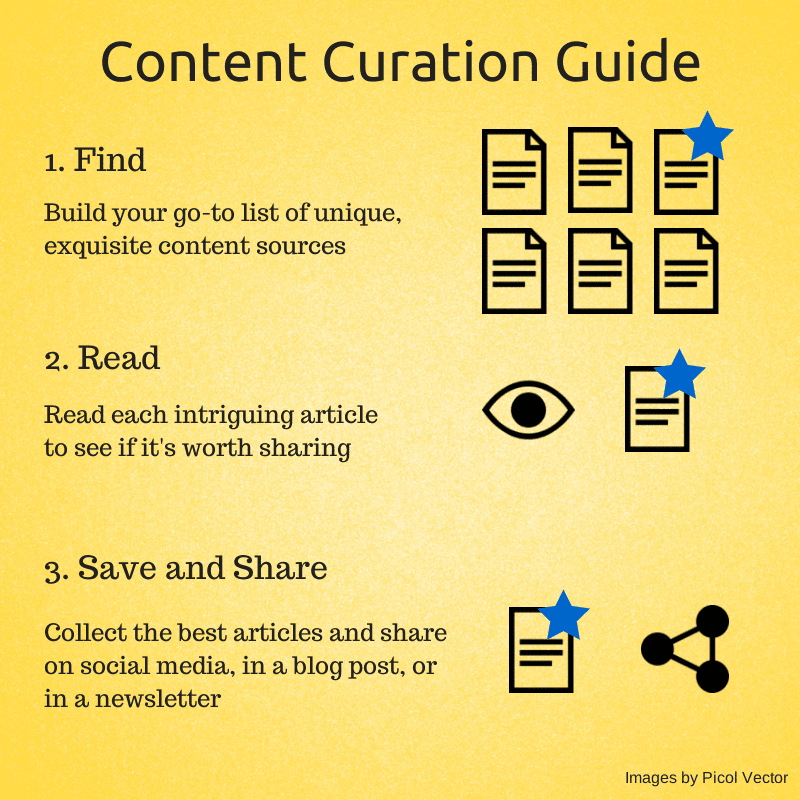
If you want to see the best possible results from your content curation strategy, you need to routinely audit it and improve it. Undergoing an audit is a time-consuming and sometimes expensive process, but it has the power to fundamentally change your strategy for the better – and ultimately help you see far greater returns.
Source: Buffer.com
So what’s the best way to approach a content curation strategy audit?
The Goals of a Content Curation Audit
Source: https://www.allbusiness.com/curated-content-100744-1.html
Ultimately, the goal of a content curation audit is to improve the efficiency and results of your content curation strategy. That can be broken down into several sub-goals, including:
· Understanding your most and least successful content. First, you need to understand which pieces of curated content were most successful and least successful. Which are the pieces that are sending thousands of people to your website and which ones are falling short? For example, is the piece about the increasing role of AI in healthcare much more popular than the piece about cryptocurrency? When you understand this, you’ll be better able to curate better content in the future – and ultimately increase your brand’s visibility and reputation.
· Better aligning with your target demographics. You’ll also need to study your target demographics. Who is your target audience and are you reaching them successfully? Different audience niches have very different needs; for example, you might be curating content related to settlement advances, but the content targeted to lawyers and the content targeted to clients are going to be quite different.
· Decreasing time spent. Part of your goal is also decreasing the amount of time you’re spending on content curation in total. If your strategy is generating hundreds of new people to your website, that’s a good thing – but if it takes your entire team hours of time every week to do it, it may not be as profitable as you imagine.
· Setting an actionable new course. Finally, your content curation audit will be focused on setting an actionable new course. It’s not just about understanding what you’ve done and what you’re doing – it’s about pulling everyone together to do something better in the future.
Keys to Success
If you want higher odds of success, you’ll need to adhere to these important keys:
· Get the whole team involved. All the people involved with content curation on your team should be involved in the audit. They don’t have to follow every step, but they should be working to understand the data and be willing to act.
· Rely on objective data. You need to rely on objective data to fuel your conclusions. While it’s perfectly acceptable – and even a good idea – to review your past content curation efforts and evaluate them subjectively, objective data is much more reliable. Focus on the numbers and form your conclusions from there.
· Make your analysis actionable. Some of your content will do well. Some will do poorly. Those conclusions alone aren’t going to help you. If you want your audit to be meaningful, it needs to be tied to specific actions. What, specifically, are you going to do to make your content more powerful from here?
Phase I: Gathering Data
Phase one of the content curation auditing process is gathering data. Hopefully, you already have a suite of tools in place to help you measure key performance indicators (KPIs) of your strategy’s performance. No matter what, you’ll want to look at things like:
· Traffic metrics. How much traffic is being generated by your content curation strategy? Which pieces of content are responsible for the greatest surge in traffic to your website? Which channels are most and least effective?
· Onsite user behavior metrics. When the stream of traffic hits your website, what happens then? Do your users seem active and engaged? Or do your users frequently bounce?
· User engagement and social metrics. How do people react to your curated content on social media channels? Are you earning lots of likes, comments, shares, and other engagements?
· Time efficiency metrics. How much time are you spending on this strategy? Are you automating as much as you can? Is the team spending too many hours on a piece of your strategy that isn’t particularly effective?
· Bottom line ROI. Finally, you’ll need to combine all these metrics to determine your content curation return on investment (ROI). How much value are you generating with your strategy and how much time and effort are you putting in?
Phase II: Analysis
In phase two, you’ll be analyzing the data. You have the numbers in front of you, but what do they really mean for your brand?
For example, is there a specific type of content that’s not performing well with your target audience? If so, is that because you’re sharing the content from a source that isn’t credible? Is your understanding of your target audience impaired? Is the format or medium what’s turning people off?
This can be hard to answer, so you may be required to seek out new sources of data. For example, can you interview members of your target audience and see what they think directly?
Phase III: Brainstorming
Source: https://www.ideou.com/blogs/inspiration/7-simple-rules-of-brainstorming
Phase three is all about brainstorming and setting a course for the future. What are you going to change and how are you going to change it?
With your analyses in hand, gather the team and talk about the potential changes you can make to your content curation strategy. Can you target a new audience? Can you rely on a different suite of tools? Can you curate different formats or mediums of content? Feel free to experiment with a variety of different tactics to see what works.
After your content curation audit, you should have a better idea of how you can more efficiently and effectively reach your target audience through content curation. Note that this isn’t a one-time upgrade; it’s an ongoing process that should be incorporated into your content curation strategy entirely. Do periodic reviews of your efforts so you can remain adaptable.





